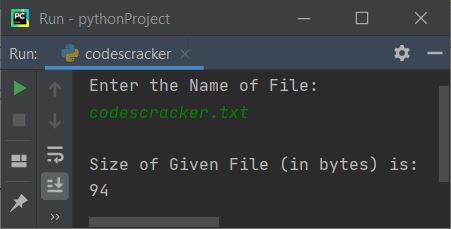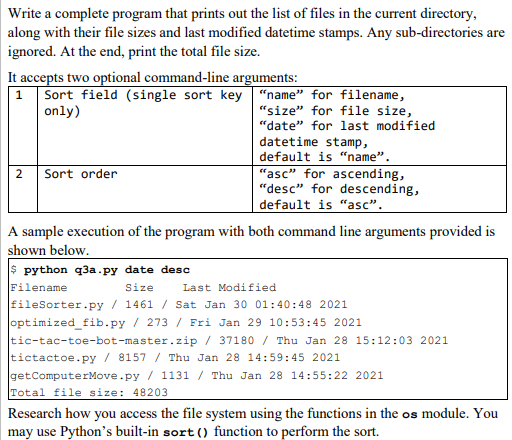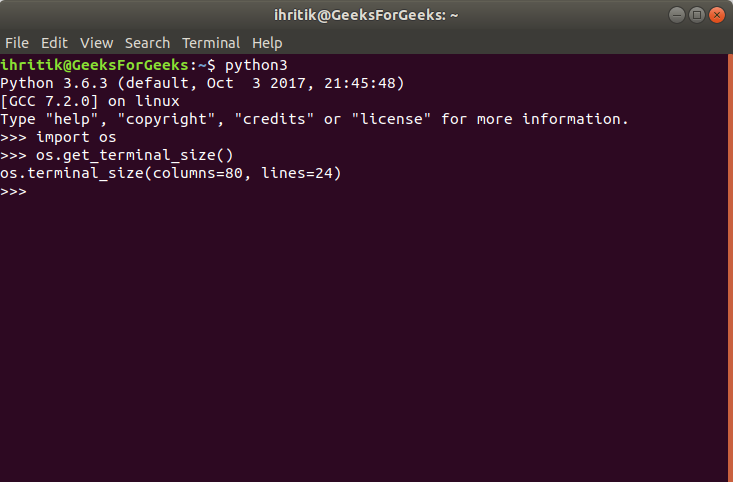Python Get Size Of File
Introduction:
Python provides various methods and modules to get the size of a file. In this article, we will discuss different techniques to obtain the file size in Python. We will explore methods using the os.path module, os.stat module, pathlib module, calculating the file size in chunks, handling large file sizes efficiently, and displaying the file size in a human-readable format. Additionally, we will answer frequently asked questions (FAQs) related to file size in Python.
Methods to Get the Size of a File in Python:
1. Using the os.path module:
The os.path module in Python provides a getsize() function to obtain the size of a file. It returns the size of the file in bytes. Here is an example:
“`python
import os
file_path = ‘path/to/file.txt’
file_size = os.path.getsize(file_path)
print(“File size:”, file_size, “bytes”)
“`
2. Utilizing the os.stat module:
The os.stat module allows access to the file’s metadata, including its size. By using the st_size attribute, we can obtain the file size in bytes. Here is an example:
“`python
import os
file_path = ‘path/to/file.txt’
file_stats = os.stat(file_path)
file_size = file_stats.st_size
print(“File size:”, file_size, “bytes”)
“`
3. Employing the pathlib module:
The pathlib module introduced in Python 3 provides an object-oriented approach to handle file system paths. It offers the stat() method to get file information, including its size. Here is an example:
“`python
from pathlib import Path
file_path = Path(‘path/to/file.txt’)
file_stats = file_path.stat()
file_size = file_stats.st_size
print(“File size:”, file_size, “bytes”)
“`
4. Calculating the file size in chunks:
For large files, it is sometimes inefficient to read the entire file to determine its size. In such cases, we can calculate the size in chunks by reading a specific amount of data at a time. Here is an example:
“`python
file_path = ‘path/to/large_file.txt’
chunk_size = 4096
file_size = 0
with open(file_path, ‘rb’) as file:
while chunk := file.read(chunk_size):
file_size += len(chunk)
print(“File size:”, file_size, “bytes”)
“`
5. Handling large file sizes efficiently:
When dealing with large files, it is crucial to optimize the file size calculation process. By utilizing the `os.path.getsize()` function, which directly returns the file size, we can efficiently obtain the size of large files. Here is an example:
“`python
import os
file_path = ‘path/to/large_file.txt’
file_size = os.path.getsize(file_path)
print(“File size:”, file_size, “bytes”)
“`
6. Displaying the file size in a human-readable format:
To make the file size more readable, we can convert it to a human-friendly format using various units such as Bytes, KB, MB, GB, etc. Here is an example:
“`python
import os
def convert_size(size_in_bytes):
units = [‘Bytes’, ‘KB’, ‘MB’, ‘GB’, ‘TB’]
index = 0
while size_in_bytes >= 1024:
size_in_bytes /= 1024
index += 1
return f”{size_in_bytes:.2f} {units[index]}”
file_path = ‘path/to/file.txt’
file_size = os.path.getsize(file_path)
human_readable_size = convert_size(file_size)
print(“File size:”, human_readable_size)
“`
FAQs (Frequently Asked Questions):
Q1: How can I get the file size in megabytes (MB) using Python?
To obtain the file size in megabytes, you can use the os.path.getsize() method and divide the size by 1024*1024. Here is an example:
“`python
import os
file_path = ‘path/to/file.txt’
file_size = os.path.getsize(file_path) / (1024 * 1024)
print(“File size:”, file_size, “MB”)
“`
Q2: How can I get the file size of an image using Python?
To get the file size of an image, you can use any of the methods mentioned above. The file size will be the same for any type of file, including images.
Q3: How do I find the length of a file in Python?
The length of a file typically refers to its size in bytes. You can use the os.path.getsize() or os.stat().st_size method to obtain the length of a file.
Q4: How can I get the stream size in Python?
The stream size depends on the nature of the stream and how it is being handled. If you are referring to a file stream, you can use the techniques mentioned in this article to get the file size. However, if you are referring to a network stream or any other specific type, please provide more details for a more accurate answer.
Q5: How can I check the file size in a Flask application?
In a Flask application, you can use any of the methods provided above, such as os.path.getsize() or os.stat().st_size, to check the file size. Ensure that you have the correct file path or handle to access the file.
Q6: How can I get the content length using the Python requests library?
The Python requests library provides a `response` object, which contains a `headers` attribute. You can access the `Content-Length` header to get the content length of a response. Here is an example:
“`python
import requests
response = requests.get(‘http://example.com’)
content_length = int(response.headers.get(‘Content-Length’))
print(“Content length:”, content_length, “bytes”)
“`
Q7: How can I get the size of a variable in Python?
The size of a variable primarily depends on the type of variable and the system architecture. To obtain the size of a variable, you can use the `sys.getsizeof()` function from the `sys` module. Here is an example:
“`python
import sys
var = “test”
var_size = sys.getsizeof(var)
print(“Variable size:”, var_size, “bytes”)
“`
Conclusion:
In this article, we covered various techniques to get the size of a file in Python. We explored methods using the os.path module, os.stat module, pathlib module, calculating the file size in chunks, handling large file sizes efficiently, and displaying the file size in a human-readable format. By understanding these techniques, you can efficiently obtain the file size in your Python programs.
Get The File Size Of A File In Python
Keywords searched by users: python get size of file Python get file size in MB, Get file size of image python, Length file python, Stream size python, Flask check file size, Get content-length python requests, Os path getsize, Get size of variable Python
Categories: Top 31 Python Get Size Of File
See more here: nhanvietluanvan.com
Python Get File Size In Mb
Introduction:
When working with files in Python, it’s not uncommon to come across scenarios where you need to determine the size of a file in megabytes (MB). Understanding how to obtain this information can be invaluable, particularly when dealing with large files or assessing storage requirements. In this article, we will explore different approaches to calculating file size in MB using Python and address common questions regarding this topic.
Methods to Get File Size in MB:
Method 1: Using the os.path Module
Python provides a built-in module called ‘os.path’ that offers various functions for manipulating file and directory paths. One such function is ‘getsize()’, which allows us to obtain the size of a file. By dividing this size by 1048576 (1024 * 1024), we can convert it into megabytes.
“`python
import os
file_path = ‘example_file.txt’
file_size_bytes = os.path.getsize(file_path)
file_size_mb = file_size_bytes / 1048576
print(f”The size of ‘{file_path}’ is approximately {file_size_mb:.2f} MB.”)
“`
Method 2: Using the stat module from the os module
The ‘os’ module offers an alternative approach to calculate file size in MB. By making use of the ‘stat’ function, which retrieves the file information, we can access the ‘st_size’ attribute, representing the file size in bytes. Similar to method 1, dividing this value by 1048576 gives us the file size in MB.
“`python
import os
file_path = ‘example_file.txt’
file_stats = os.stat(file_path)
file_size_bytes = file_stats.st_size
file_size_mb = file_size_bytes / 1048576
print(f”The size of ‘{file_path}’ is approximately {file_size_mb:.2f} MB.”)
“`
Method 3: Using the pathlib module
The ‘pathlib’ module introduced in Python 3.4 provides a comprehensive approach to path manipulation. With the ‘Path’ class from this module, we can easily determine the size of a file using the ‘stat()’ method. The size information is accessed through the ‘st_size’ attribute, which can then be converted to MB.
“`python
from pathlib import Path
file_path = Path(‘example_file.txt’)
file_size_bytes = file_path.stat().st_size
file_size_mb = file_size_bytes / 1048576
print(f”The size of ‘{file_path}’ is approximately {file_size_mb:.2f} MB.”)
“`
FAQs:
Q1: Can these methods be used for files located on remote servers?
A1: No, these methods work only for files on the local file system. To retrieve file sizes from remote servers, additional steps, such as establishing a connection and sending a request, are required.
Q2: Are there any limitations to handling large file sizes?
A2: The size of the file must be within the system’s file size limitations. For example, in some systems, you may encounter issues if the file size exceeds 2 or 4GB.
Q3: What happens if the file does not exist?
A3: If the file does not exist in the given location, the ‘FileNotFoundError’ exception will be raised by the ‘getsize()’ function.
Q4: What if I want to calculate the size of a directory?
A4: The methods discussed in this article are specifically designed for files, not directories. However, you can modify them to iterate through the files within a directory and sum up the individual file sizes to calculate the directory size.
Q5: How can I display the file size in a friendlier format, such as “x GB y MB”?
A5: To achieve a more user-friendly format, you can divide the file size by 1024 repeatedly to calculate larger units (GB, TB). Additionally, you can use string formatting to present the size with appropriate units.
Conclusion:
Knowing how to determine the file size in MB using Python is an essential skill for any developer working with file-centric applications. In this article, we explored three distinct methods to retrieve the size of a file in MB, utilizing the ‘os.path’, ‘os.stat’, and ‘pathlib’ modules. Additionally, we addressed several frequently asked questions to clarify common concerns related to this topic. By mastering these techniques, you’ll have the necessary tools to efficiently handle and evaluate file sizes in your Python projects.
Get File Size Of Image Python
A common task when working with images in Python is to determine the size of a particular file. This information can be useful for various purposes, such as checking if an image meets certain size requirements, optimizing image loading times, or simply gathering metadata about the image.
In this article, we will explore how to get the file size of an image in Python and discuss different methods to achieve this task. We will cover both standard Python libraries and third-party packages that provide convenient functions for dealing with image file sizes.
Method 1: Using the ‘os’ module
One of the simplest ways to get the file size of an image in Python is by using the built-in ‘os’ module. This module provides a function called ‘path.getsize()’ that returns the size of a file in bytes.
To use this method, you need to import the ‘os’ module and provide the path to the image file. Here’s an example:
“`python
import os
file_path = ‘path/to/image.jpg’
file_size = os.path.getsize(file_path)
print(f”The file size is {file_size} bytes.”)
“`
Method 2: Using the ‘PIL’ (Pillow) library
Another popular approach to obtaining the file size of an image in Python is by utilizing the ‘PIL’ (Python Imaging Library, now known as Pillow) library. This library provides a comprehensive set of image processing functions and supports various image formats.
First, make sure you have the ‘Pillow’ library installed. If not, you can install it by running ‘pip install pillow’.
Once you have ‘Pillow’ installed, you can use the following code to get the file size:
“`python
from PIL import Image
import os
file_path = ‘path/to/image.jpg’
image = Image.open(file_path)
image_size = os.stat(file_path).st_size
print(f”The image size is {image_size} bytes.”)
“`
Method 3: Using the ‘imghdr’ module
The ‘imghdr’ module is a built-in Python module that provides functions for determining the type of an image file. Although its primary purpose is not to get the file size, we can take advantage of its ‘test()’ function to achieve this goal.
To use this method, follow the code snippet below:
“`python
import imghdr
file_path = ‘path/to/image.jpg’
image_format = imghdr.what(file_path)
if image_format:
file_size = os.stat(file_path).st_size
print(f”The image size is {file_size} bytes.”)
else:
print(“The file is not a valid image.”)
“`
FAQs:
Q: Is it necessary to install any additional libraries to get the file size of an image in Python?
A: No, you can use the built-in ‘os’ module if you don’t require any further image processing capabilities. However, if you need additional functionalities, installing the ‘Pillow’ library can be beneficial.
Q: Can I use the methods mentioned in this article with any image file format?
A: Yes, the methods described can be used with most common image file formats such as JPG, PNG, GIF, and BMP, among others.
Q: Do these methods work for remote image files, such as those hosted on a website?
A: No, these methods determine the size of a local file. If you need to retrieve the size of a remote image file, you may need to download it first or use an API provided by the remote server.
Q: How do I handle errors when using these methods?
A: It is a good practice to include appropriate error handling when dealing with file operations. You can use try-except blocks to catch any exceptions that may occur, such as file not found errors or permission issues.
Conclusion:
Getting the file size of an image is a fundamental task in image processing. In this article, we explored different approaches to achieve this task in Python, including using the ‘os’ module, the ‘PIL’ library, and the ‘imghdr’ module. Depending on your requirements and the available resources, you can choose the method that best suits your needs.
Remember to handle any potential errors and consider the implications of remote image files when implementing these methods. Armed with this knowledge, you are now equipped to efficiently retrieve image file sizes in Python!
Images related to the topic python get size of file

Found 33 images related to python get size of file theme








![How to check file size using PowerShell Script [Easy Way] - SPGuides How To Check File Size Using Powershell Script [Easy Way] - Spguides](https://i0.wp.com/www.spguides.com/wp-content/uploads/2018/01/calculate-file-size-using-PowerShell.png)






_list-files-of-a-directory-and-sort-the-files-by-file-size-in-python.jpg)


![Python Count Number of Lines in a File [5 Ways] – PYnative Python Count Number Of Lines In A File [5 Ways] – Pynative](https://pynative.com/wp-content/uploads/2021/06/sample_text_file-1.png)



















Article link: python get size of file.
Learn more about the topic python get size of file.
- How to Get File Size in Python | DigitalOcean
- Python Check File Size – PYnative
- Getting file size in Python? [duplicate] – Stack Overflow
- Get file size in python in 3 ways – codippa
- How to get file size in Python? – GeeksforGeeks
- How to Get File Size in Python in Bytes, KB, MB, and GB • datagy
- Python How to Check File Size (Theory & Examples)
- Different Ways to Get the Size of a File in Python – Turing
- Python Program to Check the File Size – Programiz
- Get File Size in Python
See more: nhanvietluanvan.com/luat-hoc